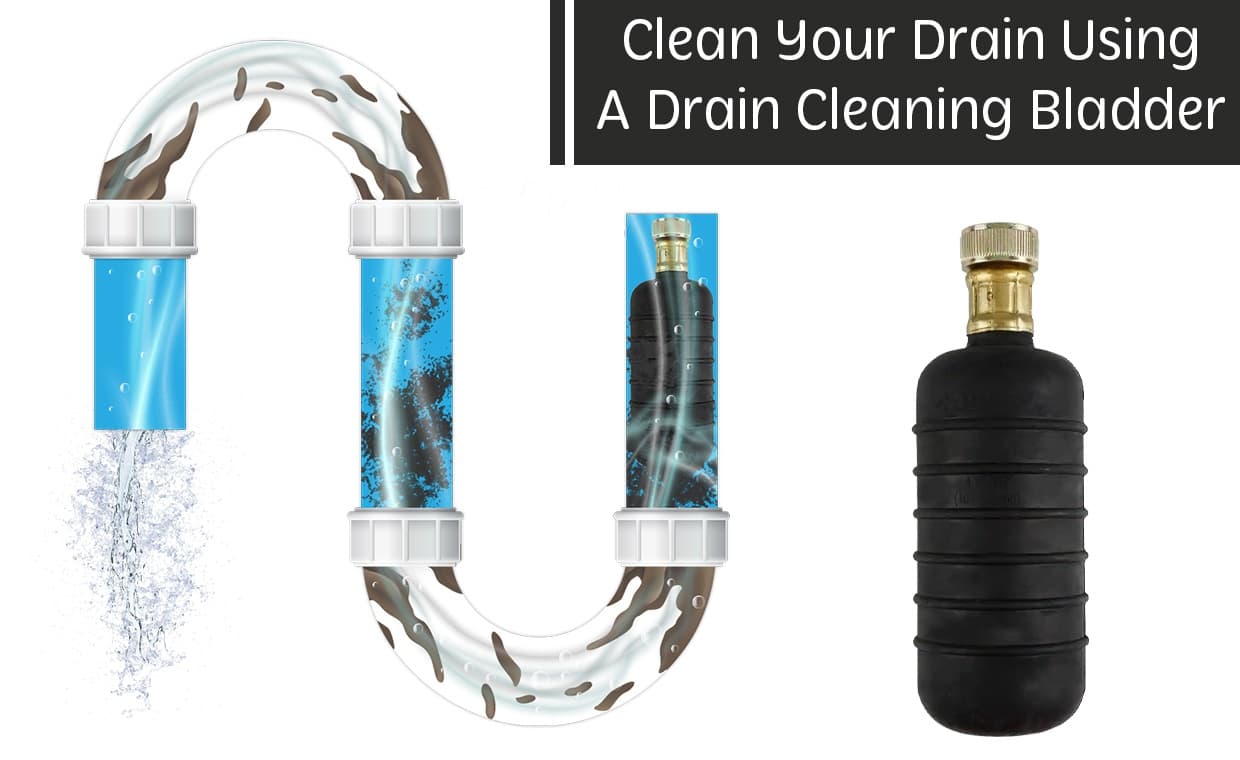
If you have ever dealt with a clogged drain in your home, you can bet that they’re a hassle to deal with. It is a time-consuming and troublesome task. However, a Drain Cleaning Bladder would come in handy to reduce the frustration drastically. It’s known for clearing the toughest clogs in drains.
So if the other unclogging methods have failed you, try the drain cleaning bladder- it doesn’t disappoint. The good thing about it is that it’s highly effective and easy to use, besides being cheap. Further, if you don’t know about, what is a drain bladder and how to use a drain bladder, and how does a drain bladder work, then here you go.
- What is a Drain Bladder?
- Things to Know Before Using a Drain Cleaning Bladder
- How to Use a Drain Bladder to Unclog the Drain?
- How to Maintain Drain Cleaning Bladder
Let’s Start…
What is a Drain Bladder?

A drain cleaning bladder is a heavy-duty bag or a balloon that pumps pressurized water to clear the clogs in a drain, basically, it’s a water pressure drain cleaner. It is incredibly effective at removing even the most stubborn clogs. It’s available in the market with different names such as Drain Cleaning Water Bladder, Drain Bladder, Drain Balloon, Plumber’s Balloon, and Clog Buster Drain Flusher etc.
These water pressure drain cleaners are available in three sizes-small, medium and large; you can choose them according to the size of your drain pipe.
- Small drain cleaning bladders are suitable for 1 and 2-inch pipes
- Medium drain cleaning bladders are suitable for 1.5 to 3-inch pipes
- Large drain cleaning bladders are suitable for 4 to 6-inch pipes
Things to Know Before Using a Drain Cleaning Bladder
Well, before you start using a drain cleaning bladder, it’s good to know some important things to work safely and smoothly.
01. It May Cause Injuries
A drain bladder can burst even without you building water pressure exceeding the stated upper limit. Therefore, always ensure that you position yourself on one side as you work with it, as you may get significant injuries from flying objects when it bursts.
02. If Subjected To Too High Pressure, A Bladder Can Burst
Yes, a drain cleaning bladder works at a maximum safe water pressure. However, when water is filled past this point, it may burst. So, before you start the unclogging process, you need to know your bladder’s pressure specification and the water pressure in your building.
If the water pressure in your workplace is too high, reduce it to the recommended level using the water pressure regulator/booster pump, in case it is fitted in your building.
03. It Can Potentially Damage Your Drain
Sometimes a drain cleaning bladder can fail to unblock a heavy clog. When this happens, the water pressure has to go somewhere. Do you know where this “somewhere” might be? Your drain line joints! If the drain line joints are weak, the water will force itself through them, leading to major damage.
With these basic things, it’s better to go through the drain bladder instructions manual before you unclog using the drain bladder.
Wait… Before you start learning how to use a drain bladder to unclog your drain, you must know these 7 Surprising Items that will Clog Your Drain, so you can prevent drain clogging and stay away from this drain cleaning hassle.
How to Use a Drain Bladder to Unclog the Drain
Wondering how to use a drain bladder? Well, here is how you use it like a veteran to unclog your drains;
Step 1: Collect Tools and Materials You’d Need

- Drain Cleaning Bladder – You can choose its size (small, medium, large) according to your drain size
- Garden Hose
- Slip-Nut Pliers
- Shut Off Valve
- Flashlight
- A Small Garden Hose
- Garden Hose Aerator Adapter
- Gloves
Step 2: Prepare Your Working Area
- First, clear the space under your sink drains
- Under the drain pipes lay down some towels, rags, or clothes to catch any waste that would fall on the floor.
- Using a bucket, collect the dirty water flowing out after disassembly- Place it under the P-trap.
- To increase visibility in the dark area, illuminate the workspace with a portable work light or a flashlight.
Step 3: Disassemble the P-Trap

- Can you see the nuts holding the P-trap in place? One nut attaches the trap to the waste tee that comes from the sink basin, while the other nut attaches the P-trap to the trap arm.
- The two nuts can be made of metal or plastic. Unscrew the two nuts using either hands or pliers. If you opt to use pliers, use them carefully to avoid damaging the fragile plastic nuts.
- After removing the nuts, check for any clogs in the P-trap to see if it was the cause of the drain blockage or not.
Step 4: Disassemble the Trap Arm
- After disassembling the P-trap, loosen the nuts connecting the trap arm.
- Remove out the trap arm from the stub of the drain (the small tube extended from the wall)
- Check if the trap arm was the source of the obstructions and clogs by visually inspecting it.
Step 5: Connect the Garden Hose to a Water Source

- Onto the water source, you’ll be using with the drain bladder, thread your garden hose end. Ensure that the garden hose can extend to reach the clogged drain.
- If you are using the outdoor bib at a distance from where you’re working, look for another person to help you turn the water off and on. However, if you can’t find somebody, you can consider using a garden hose shut-off valve attached to a smaller water hose.
Wondering how? Okay, follow these steps;

- Connect the shut-off valve to the main garden hose connected to the water faucet.
- Then connect the smaller water hose to the shut-off valve with the drain cleaning bladder attached to the small hose end. By so doing, you’ll be able to keep on the outdoor water as you control the water flow with the shut-off valve.
- Unscrew the aerator (the small cap at the faucet tip where water comes out) and replace it with the garden hose adapter and connect the drain bladder to the faucet of the sink.
- Ensure that you use cold water from the sink because the hot water can damage the drain cleaning bladder.
Step 6: Attach the Drain Cleaning Bladder to the Garden Hose
- Onto the garden hose end, hand tightens the end of your drain cleaning bladder.
Step 7: Insert the Drain Cleaning Bladder into the Drainage Pipe
- Insert the bladder’s tip into the drainage pipe and press and wiggle it carefully at least six inches into the drain. Ensure that it is deep enough to have a direct route to the clog. Avoid placing it before a tee as the spray would move on the less resistant path and pass through the drainage vent to the roof.
- Ensure that you slide the drain cleaning bladder past the tee to avoid this. And possibly push the bladder into the drainage pipe until it comes into contact with the clog.
Step 8: Blast the Clog

This step shows the, ‘how does a drain bladder work’.
- Turn on slowly the cold water and let the bladder inflate.
- To prevent the backflow of uncommon pressurized water from splashing you, position yourself away from the drain opening.
- Keep on filling the drain cleaning bladder with water. When the pressure is high enough, the other end of the bladder will open and start spraying the pressurized water into the drain cutting through the clog. Let the bladder work for about three to four minutes till you’re sure that the drain is clear.
- Now shut the water supply off and let the bladder deflate for a minute.
Step 9: Retract the Drain Cleaning Bladder
- Wear gloves to avoid touching waste material from the drain and carefully remove the drain bladder from the wall. Please don’t remove the bladder until it is fully deflated, as you can cause damage to both the bladder and the pipe.
- From the garden hose, unscrew the drain bladder and place it in a bucket or sink and clean it properly.
Step 10: Test the Drain

- To test if the drain is clear, reinsert the garden hose and turn on the water to fill the drain.
- If the water freely runs into the drain without backflow, the drain is clear. However, if the water backflows out of the drain, then your drain is still clogged. In this case, you’ll have to repeat the process as many times as possible until the clog is cleared.
Step 11: Reattach the Drain Pipes
- Reattach the trap arm and the P-trap to the waste tee and the trap arm on the wall.
- Verify your fix and test the connection of the drain pipes by running some water down the sink.
How to Maintain Drain Cleaning Bladder?
- Ensure that you rinse the drain cleaning bladder well to clean any residual debris or waste; then, let it dry.
- After drying, check the bladder thoroughly if it shows any sign of damaging or cracking. You should check it before and after every use.
- For protecting your drain cleaning bladder, you can apply a light coating of silicone lubrication.
I am sure these steps will guide you well to unclog the drain using the bladder like a pro. But, it’s also recommended to read the drain bladder instructions manual first using it. Likewise, regarding how to use a drain bladder, we also have written easy-peasy steps on How to Use a Plumber’s Snake to Unblock the House Drain?
Have you followed all the above steps to the latter? If yes, then clear your doubts and roll your sleeves to remove the clogs like a pro.
If you are frustrated with these drainage problems at your home and don’t know how to solve them, then don’t worry – Gharpedia is here… You can write to us about your problems; we will try our best to give you a reliable and pocket-friendly solution for your problems. Till then, you can take a glance at our drainage category blogs.
Image Courtesy – Image 2, Image 7
Author Bio
Fidelis Kinai – Fidelis Muti possess a bachelor’s in English and Journalism and have over four years of professional experienced writing and proofreading materials for print and online platforms, including newspapers, magazines, websites, blogs, and social media accounts. He also have over three years of experience as a marketing assistant and social media manager.
He is versatile and diligent and will produce exemplary content within time to meet your deadline.
He can deliver most work within 2-3 days; rush orders are accepted whenever possible. He is based in the Kenya but travel often and work for clients all over the world.






























